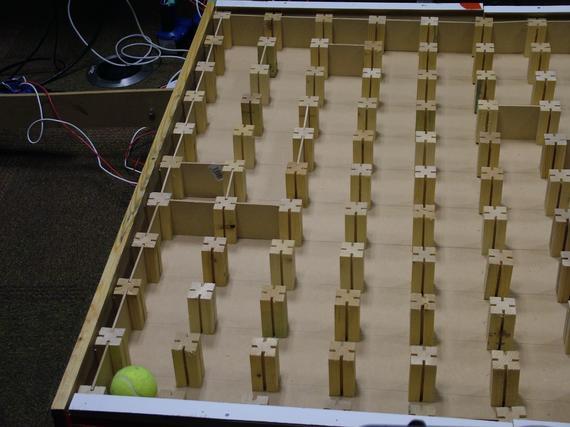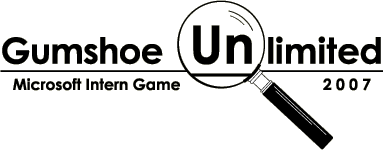Minotaur Solution
How It Works
At the beginning of the Game, teams were given a package of dice and told to retain it for later use. The grid of letters was distinctive in that the top left square had two numbers surrounding it – one above and one to the left of the square. The squares were also sized exactly to match a die. These two attributes combined to make it possible to orient and place the die in the top left square. From there, it is a matter of following the dice maze (e.g. move the die a number of squares equal to the value on the face matching that direction) to spell out a phrase. One set of dice mazes (the red set) spelled out "What year was Microsoft founded", and the other (the blue set) spelled "What year did Columbus discover America". The answers – 1975 and 1492 – unlocked the computers matching the color of the maze.
Once the four red computers unlocked, a simple dynamically changing maze appeared onscreen. Teams could move a red dot through the maze with the arrow keys on their keypad. Walls randomly appeared and disappeared on a timetable, and there were also red ‘fire pits’ that would warp the dot to a random square elsewhere in the grid.

When the blue computer unlocked, however, the Minotaur came to life. It activated and rose into the upright position and then tilted to north. (Up until this point, music had been playing; the reveal played its own music, but once complete, the room was silent.) The blue machine revealed a green radar screen and four dots, labeled A-D. There are also four regions on the radar map, labeled N, S, E, and W.
Teams needed to move the dots on each of the four red computers to all be in the same region on the radar map. (Each computer controlled one of the A-D dots.) When all four dots ‘voted’ on the same square, a new dialog appeared: "Unlock movement in
Solution
The wooden maze that was mounted on top of the Minotaur apparatus contained a relatively straightforward tilt maze. Teams needed to repeat the ‘vote to unlock’ process to unlock each maze direction. Eventually, teams navigated the tennis ball to the hole in the bottom of the maze and were rewarded with an envelope containing the answer to the puzzle.
Design Notes
We could fill paragraphs and paragraphs with the design process for Minotaur – but here are some of the highlights of the design and construction process.
The motorized apparatus was constructed from four car jacks, four 18V cordless drills from Harbor Freight Tools, and a ton of wood and mounting hardware. We had to custom fabricate or obtain several critical parts, each of which was fondly given its own name:
- The "butter knives" were the wood pieces that connected the jacks to the drills (named because the original prototype was shaped like a butter knife)
- The "bridles" were metal pieces that connected the jack to the "butter knife" (named because they kept the jacks under control)
- The orange spring clips that connected the drills to the "butter knife" were known as "Pony clips", after the brand name of clamp that we ended up buying.
- To create convenient battery holders, we used a hacksaw to cut each drill in half – the grip portion of the drill became the battery holder, while the main body of the drill was attached to the butter knife.
The original design for the motorized apparatus involved building a complex custom linear actuator. At one point, we were trying to hammer together a component but didn’t have a hammer handy. Adam quickly procured his car’s emergency jack as a suitable substitute, and while we were attacking the component with it, one of us said "I wish we could just find an off-the-shelf product that translates rotational motion into vertical motion!" We both stopped, stared at the jack, and the rest is history 😃
Pretty much every part in the system underwent at least one design revision. For example, the butter knives were originally attached by bolts that went into holes drilled into the jack and tapped to add threading – but the tapping process was unpredictable and necessitated the invention of the bridles instead.
The electronic controls were built using high-end motor controllers designed for Battlebots (since 18V drill motors are capable of drawing hundreds of amps of current in the worst case). The switches we used were originally intended for arcade machine cabinets and were interfaced to the computer through a USB-enabled Microchip PIC. The software was built entirely in .NET (the blue computer’s software was built in WPF and the red software was built in Windows Forms.)
Partway through the construction process, our entire supply of hand tools was stolen from a Microsoft building overnight, which caused a several-week setback (since several critical parts were in the box with the tools.) This was the inspiration for Pregame 9, where teams were asked to try to solve a case of a missing toolbox on the Microsoft campus.
A number of folks were gracious enough to spend a Saturday with us fabricating the second Minotaur once design work was completed on the first one. Special thanks to everyone who participated and helped us complete the work with minimal injuries 😃
The orange spring clips that connected the drills to the "butter knife" were known as "Pony clips", after the brand name of clamp that we ended up buying.
To create convenient battery holders, we used a hacksaw to cut each drill in half – the grip portion of the drill became the battery holder, while the main body of the drill was attached to the butter knife.
Pretty much every part in the system underwent at least one design revision. For example, the butter knives were originally attached by bolts that went into holes drilled into the jack and tapped to add threading – but the tapping process was unpredictable and necessitated the invention of the bridles instead.
The electronic controls were built using high-end motor controllers designed for Battlebots (since 18V drill motors are capable of drawing hundreds of amps of current in the worst case). The switches we used were originally intended for arcade machine cabinets and were interfaced to the computer through a USB-enabled Microchip PIC. The software was built entirely in .NET (the blue computer’s software was built in WPF and the red software was built in Windows Forms.)
Partway through the construction process, our entire supply of hand tools was stolen from a Microsoft building overnight, which caused a several-week setback (since several critical parts were in the box with the tools.) This was the inspiration for Pregame 9, where teams were asked to try to solve a case of a missing toolbox on the Microsoft campus.
A number of folks were gracious enough to spend a Saturday with us fabricating the second Minotaur once design work was completed on the first one. Special thanks to everyone who participated and helped us complete the work with minimal injuries 😃
GC Notes
Most teams saw this puzzle on Sunday, because a confluence of minor problems (on one instance, a lack of video drivers caused WPF to switch to software rendering mode, which slowed down the sensor polling loop enough to cause the jacks to drive past their limits; on the other, the polling loop was too sensitive and stopped the jacks before they could begin moving) limited the number of teams that could visit the puzzle Saturday night. Again, special thanks to everyone from GC who helped with troubleshooting!
